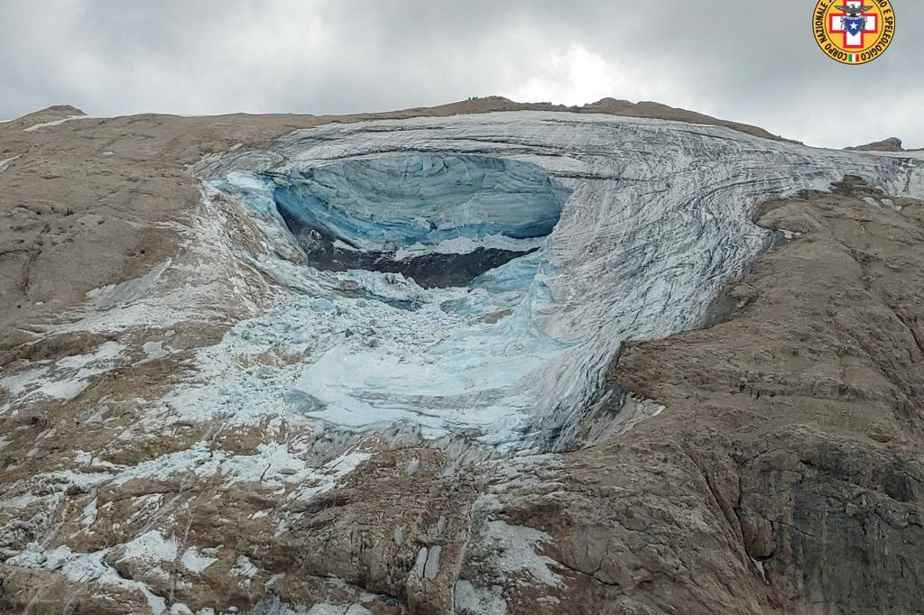(Canazei) Search operations for possible survivors were to resume on Monday after the collapse due to a heat wave of part of the Marmolada glacier, the largest in the Italian Alps, which left at least six dead and eight injured.
Updated yesterday at 10:04 p.m.
Relief spokeswoman Michela Canova told AFP on Sunday evening that the death toll, initially five dead, had risen to “six confirmed victims”.
Eight injured are also to be deplored, she announced, without giving details on the nationality of the victims. According to Italian media, foreign nationals were among the roped parties carried away by the avalanche.
The head of civil protection in the province of Veneto, Gianpaolo Bottacin, also mentioned “disappeared” on his Facebook account. Alpine rescue has activated a toll-free number to allow reports to people who have not heard from relatives who have gone on an excursion on the glacier.
The head of the Italian government Mario Draghi sent in a message on Twitter “his most sincere condolences” to the victims and their families.
Several helicopters were immediately deployed to participate in the rescue operations and monitor the evolution of the situation, but the search had to be suspended at nightfall before resuming Monday morning. This collapse occurred the day after a temperature record at the top of the glacier of 10°C.
The collapse of the Marmolada “is the consequence of the current meteorological conditions, that is to say an episode of early heat which coincides with the problem of global warming”, explained to AFP Professor Massimo Frezzotti, from the department of Sciences from Rome 3 University.
“From what you can see in the footage, the collapse was significant. We can see that there is a large quantity of water because the melting has accelerated in the Alps. We had an extremely arid winter, with a rainfall deficit of 40-50%. Current glacier conditions correspond to mid-August, not early July,” according to the researcher.
The rescue spokeswoman described “an avalanche of snow, ice and rock which in its path hit the access road when several roped parties were there, some of whom were swept away”. “The definitive number of climbers involved is not yet known,” she added.
The glacier collapsed near the locality Punta Rocca, along the route normally taken to reach its summit.
“Queen of the Dolomites”
Footage filmed from a shelter near the disaster shows snow mixed with rock rolling down the slopes of the mountain with a crashing sound. Other images taken by tourists on their mobile phones show the avalanche’s grayish tongue from afar, sweeping away everything in its path, leaving no chance for climbers in its path.
On images transmitted by the Alpine rescue, we can see the rescuers working near the site of the disaster overflown by helicopters to transport the victims in the valley to the village of Canazei, not far from the place from where the cable car leaves. which leads to the summit of the glacier.
The work of the rescuers, helped by canine units, was particularly difficult, because they had to extract the bodies from the gangue of ice mixed with rock where they were.
A cell of psychologists has also been activated to help the relatives of the victims. The Trente public prosecutor’s office has opened an investigation to determine the causes of this tragedy.
The Marmolada glacier, nicknamed “the queen of the Dolomites”, is the largest glacier in this mountain range in northern Italy, which is part of the Alps. Located in Trentino, it gives birth to the Avisio River and overlooks Lake Fedaia.
According to the report of the Intergovernmental Panel on Climate Change (IPCC) published on 1er March, the melting of ice and snow is one of the 10 major threats caused by global warming, disrupting ecosystems and threatening certain infrastructures.
The IPCC indicates that glaciers in Scandinavia, central Europe and the Caucasus could lose 60 to 80% of their mass by the end of the century. The traditional life of peoples like the Sami in Lapland, who practice reindeer herding, is already disrupted. In Canada and Russia, thawing permafrost is hampering economic activities.
